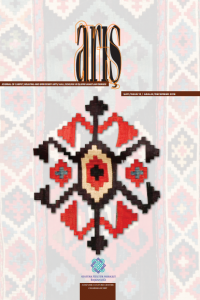Öz
The aim of this article is to comment on Nusretiye Mosque’s -which is in
Istanbul’s Tophane district- historical location, its place in important
innovations of its era and its structural changes which have been taken place
since its first construction; through the terms of our art, architecture and
cultural history. The construction of the mosque, located in Beyoglu’s Tophane
district, outside the borders of historical Istanbul, started in June of 1823 and
was completed by the April 8 1826. The mosque is a selâtin (imperial) creation
in which we can see features of both baroque and imperial style. In addition
to this another feature that makes the building different is, because of its
historical location there is a lot of political commentary regarding the building.
The name of Nusret (victory) is one of the important events of the period and
will be referred as Vaka-i Hayriye in future and it is believed that the name was
given as a reference for abolition of janisary corpses by Sultan Mahmoud II.
However this view leads us to ignore all other possibilities. We believe that it
would be more useful to approach the matter from another point of view that
is by taking into account of main meaning of the word “Nusret” which means
“victory” in the written publications of art history.
Anahtar Kelimeler
Ottoman Architecture Sultan Mahmoud II. Istanbul Tophane Nusretiye Mosque Mosque
Kaynakça
- Aslanapa, Oktay, (2004). Osmanlı Devri Mimarisi, İnkılap Yay., İstanbul.
- Ayvansarayi Hüseyin Efendi, Hadîkat’ül Cevâmi, Hadikatü’l Ceva-mi (2. Bölüm), İstanbul, H. 1281, s. 63-65.
- Ayvansarayi Hüseyin Efendi, (2001). Hadîkat’ül Cevâmi İstanbul Camileri ve Diğer Dini Sivil Mimari Yapılar, İstanbul, s. 461-463.
- Can, Selman, (2010). Bilinmeyen Olayları ve Aktörleri İle Son Dönem Osmanlı Mimarlığı, Erzurum İl ve Kültür Tur. Bak., İstanbul.
- Cezar, Mustafa, (2002). Osmanlı Başkenti İstanbul, EKAV. Vakfı Yay., İstanbul.
- Çelik, Zeynep, (2015). 19. Yüzyılda Osmanlı Başkenti; Değişen İstanbul, T.C. İş Bank. Yay., İstanbul.
- Çetintaş, M. Burak, (2005). Dolmabahçe’den Nişantaşı’na, Antik A.Ş. Kültür Yay., İstanbul.
- Develioğlu, Ferid, (2013). Osmanlıca-Türkçe Ansiklopedik Lûgat, Aydın Kitabevi Yay., Ankara.
- Ertuğ, Necdet (Edtr.), (2006). İstanbul Tarihi Çeşmeler Külliyatı, İSKİ. Gen. Müd. Yay., İstanbul.
- Eyice, Semavi, (2007). “Nusretiye Camii”, TDV İslâm Ansiklopedisi, Cilt. 33, Ankara, s. 274-276.
- Kuban, Doğan, (2016). Osmanlı Mimarisi, YEM Yay., İstanbul.
- Kumbaracılar, İzzet, (2008). İstanbul Sebilleri, Kapı Yay., İstanbul.
- Mehmed Raif, (H.1314). Mir’at-ı İstanbul, İstanbul.
- Özkafa, Fatih, (2008). İstanbul Selâtin Camilerinin Kuşak Yazıları, Yayımlanmamış Doktora Tezi, Konya.
- Öz, Tahsin, (1997). İstanbul Camileri, TTK. Yay., Ankara.
- Pehlivan Nuran, Urfalıoğlu Nur, Yazıcıoğlu Lütfi, (2000). Osmanlı Başkenti İstanbul’da Çeşmeler, YEM Yay., İstanbul.
- Şerifoğlu, Ömer Faruk, (1995). Su Güzeli; İstanbul Sebilleri, İBB. Kült. Yay., İstanbul.
- Tali, Şerife, (2011). Tarihi İstanbul Camilerinde Şadırvanlar, Ankara.
Öz
Bu makalenin amacı, İstanbul’un Tophane semtinde yer alan Nusretiye Camii’
nin gerek tarihsel konumu, gerekse dönemin önemli yenilikleri içinde nasıl bir
yer tuttuğu ve inşasından günümüze geçirdiği yapısal değişimlere; sanat, mimari ve kültür tarihimiz açısından değinmektir. Beyoğlu’nun Tophâne semtinde, tarihî İstanbul’un sınırları dışında yer alan caminin inşasına 1823 yılının
Haziran ayında başlanmış, 8 Nisan 1826’da tamamlanmıştır. Barok ve Ampir
üslubun bir arada görüldüğü eser bir selâtin camidir. Bunun yanı sıra yapıyı
farklı kılan özelliği; tarihsel konumu sebebiyle hakkında çok fazla politik yorumun olmasıdır. Caminin adı kitâbesinde Câmi-i Nusret şeklinde geçiyorsa
da yapı, halk arasında genellikle Tophane Camii olarak bilinir. Nusret adının,
dönemin önemli olaylarından biri olup sonrasında Vaka-i Hayriye olarak anılacak olan; Sultan II. Mahmud’un yeniçeri ocağını kaldırması münasebetiyle verildiği kabul edilmektedir. Fakat bu görüş bizi diğer tüm ihtimalleri yok saymaya
götürmektedir. Sanat tarihi kaynaklarına “zafer” anlamıyla geçen “nusret” kelimesinin asıl anlamlarını ele alarak meseleye farklı bir bakış açısıyla yaklaşmanın
faydalı olacağı kanaatindeyiz.
Anahtar Kelimeler
Osmanlı Mimarlığı Sultan Mahmud II İstanbul Tophane Nusretiye Camii Camii
Kaynakça
- Aslanapa, Oktay, (2004). Osmanlı Devri Mimarisi, İnkılap Yay., İstanbul.
- Ayvansarayi Hüseyin Efendi, Hadîkat’ül Cevâmi, Hadikatü’l Ceva-mi (2. Bölüm), İstanbul, H. 1281, s. 63-65.
- Ayvansarayi Hüseyin Efendi, (2001). Hadîkat’ül Cevâmi İstanbul Camileri ve Diğer Dini Sivil Mimari Yapılar, İstanbul, s. 461-463.
- Can, Selman, (2010). Bilinmeyen Olayları ve Aktörleri İle Son Dönem Osmanlı Mimarlığı, Erzurum İl ve Kültür Tur. Bak., İstanbul.
- Cezar, Mustafa, (2002). Osmanlı Başkenti İstanbul, EKAV. Vakfı Yay., İstanbul.
- Çelik, Zeynep, (2015). 19. Yüzyılda Osmanlı Başkenti; Değişen İstanbul, T.C. İş Bank. Yay., İstanbul.
- Çetintaş, M. Burak, (2005). Dolmabahçe’den Nişantaşı’na, Antik A.Ş. Kültür Yay., İstanbul.
- Develioğlu, Ferid, (2013). Osmanlıca-Türkçe Ansiklopedik Lûgat, Aydın Kitabevi Yay., Ankara.
- Ertuğ, Necdet (Edtr.), (2006). İstanbul Tarihi Çeşmeler Külliyatı, İSKİ. Gen. Müd. Yay., İstanbul.
- Eyice, Semavi, (2007). “Nusretiye Camii”, TDV İslâm Ansiklopedisi, Cilt. 33, Ankara, s. 274-276.
- Kuban, Doğan, (2016). Osmanlı Mimarisi, YEM Yay., İstanbul.
- Kumbaracılar, İzzet, (2008). İstanbul Sebilleri, Kapı Yay., İstanbul.
- Mehmed Raif, (H.1314). Mir’at-ı İstanbul, İstanbul.
- Özkafa, Fatih, (2008). İstanbul Selâtin Camilerinin Kuşak Yazıları, Yayımlanmamış Doktora Tezi, Konya.
- Öz, Tahsin, (1997). İstanbul Camileri, TTK. Yay., Ankara.
- Pehlivan Nuran, Urfalıoğlu Nur, Yazıcıoğlu Lütfi, (2000). Osmanlı Başkenti İstanbul’da Çeşmeler, YEM Yay., İstanbul.
- Şerifoğlu, Ömer Faruk, (1995). Su Güzeli; İstanbul Sebilleri, İBB. Kült. Yay., İstanbul.
- Tali, Şerife, (2011). Tarihi İstanbul Camilerinde Şadırvanlar, Ankara.
Ayrıntılar
| Birincil Dil | Türkçe |
|---|---|
| Bölüm | Makaleler |
| Yazarlar | |
| Yayımlanma Tarihi | 2 Aralık 2018 |
| Yayımlandığı Sayı | Yıl 2018 Sayı: 13 |


